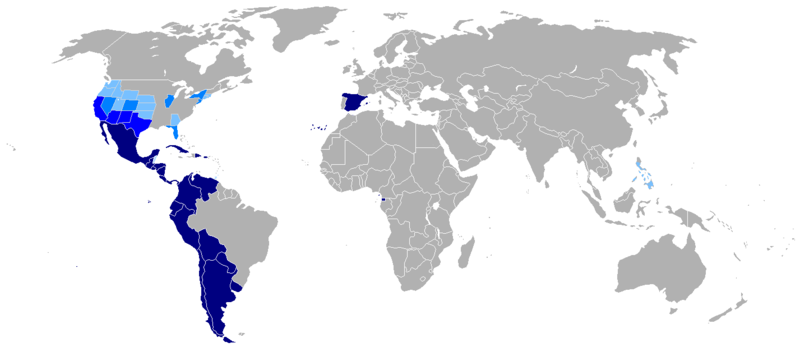 Latinoamérica
Latinoamérica
Now that we have destabilized our notion of America as exclusively the United States, we can examine Latin America as also America. Watch “Latinoamérica” by Calle 13 and pay close attention to the cultural products and practices mentioned as well as the sentiments expressed in the song.
https://vimeo.com/62380107
Comprensión
A pensar
- What does Calle 13 want to convey about Latin America in the song?
- The song begins with and recycles the word “soy”. Do you remember what that word means? What effect does this repetition produce in you as a listener?
Indefinite and Definite Articles
Watch Easy Definite and Indefinite Articles in Spanish to learn about how to use indefinite articles (un, unos, una, unas) and definite articles (el, la, los, las).
Determine if each sentence refers to a specific or general person or thing.
- Es la española.
- Es una historia.
- Son unos días festivos.
- Es el mapa.
Un, una, unos, unas
Can you pick out two of the cultural contributions or references to history presented in the song “Latinamérica”? Complete the sentences using un/una/unos/unas (a, an, some). See Lyrics in Spanish for help.
- “Una fábrica de humo” es _____ maquiladora ______________ (mexicano / mexicana / mexicanos / mexicanas).
- “El amor en los tiempos de cólera” es _____ novela ______________ (colombiano / colombiana / colombianos / colombiana) por Gabriel García Márquez.
- Los “discursos políticos sin saliva” son _____ gobiernos dictatoriales o _____ políticos __________________ (corrupto / corrupta / corruptos / corruptas).
- “Una canasta de frijoles” es _____ comida __________________ (caribeño / caribeña / caribeños / caribeñas).
- “Los que sostienen mi bandera” son _____ personas __________________ (orgulloso / orgullosa / orgullosos / orgullosas) de su origen.
Contribuciones culturales
Now discuss what each of the five references reveal about Calle 13’s notion of Latin America.
Nouns and Adjectives
Did you correctly identify the adjective that agrees with the noun in the activity “Un, una, unos, unas” above? Watch Bossy, bossy nouns (agreement) below to learn how to make adjectives agree in number and gender with nouns.
Now write the appropriate gender and number of the adjective in parenthesis for each sentence.
- Mis amigas _________________ (latino) son ________________ (nativo) de Estados Unidos.
- Este camino es ________________ (largo).
- La plaza no es muy ________________ (típico).
- Los barrios en el norte son __________________ (bueno).
- Santa Fe es una ciudad ________________ (perfecto.)
Tú no puedes comprar …
In the second part of the song, the verses begin, “Tú no puedes comprar … ” (You can’t buy … ).
- In English, name three things in the song lyrics that can’t be bought.
- Why does the poetic voice emphasize these ideas as impossible to purchase?
- Determine if the following statements are true for you and your partner. If you disagree, discuss your reasons.
- Tú no puedes comprar unos productos.
- Tú no puedes comprar la nacionalidad.
- Tú no puedes comprar el mundo.
- Tú no puedes comprar el amor.
- Tú no puedes comprar una computadora.
- Briefly discuss why each sentence uses the indefinite article (un, una … ) versus the definite article (el, la … )
Talking about what we have
Tengo …
Tengo translates as “I have” and comes from the infinitive verb tener. See the verses below to quickly view a translation.
- What is the function of tengo in these verses?
- How does the verses’ use of tengo relate to the message of the song “Latinoamérica”?
Learn how to use all forms of the verb tener by watching the video below, Spanish Lesson – Present Tense – Tener.
¿Qué tiene Latinoamérica?
Inventa oraciones completas usando la forma correcta del verbo tener, la lista de regiones y personas (1 – 5) y la lista de rasgos geográficos.
Modelo: Colombia, Brasil y Bolivia tienen la Amazonia.
- Chile y Argentina …
- Panamá …
- ¿Tú eres caribeña? Entonces tú …
- Soy puertorriqueño y …
- *Mi padre y tú sois/son mexicanos y …
*Sois is the vosotros form used in Spain, whereas son is used in the U.S. and Latin America. You may be asked to learn the vosotros form in your class.
Mis versos
As we discussed, Calle 13’s song “Latinoamérica” uses “soy … ” to present metonyms that personify Latin American culture and history. Now it is your turn to write some verses to talk about yourself or, if you wish, an imaginary identity.
¡Ojo! Make sure to use indefinite articles (un, una … ) and definite articles (el, la … ) when appropriate.
- Soy …
- Soy …
- No puedes comprar …
- Tengo …
After completing this theme, I can …
- in English, interpret the message of the song “Latinoamérica” by Calle 13 by explaining some of the cultural references mentioned.
- in Spanish, mention general and specific people, places, and things using indefinite (un, una … ) and definite (el, la … ) articles.
- in Spanish, talk about what you can’t do using the phrase “tú no puedes … “.
- in Spanish, talk about what someone has using the conjugated forms of the verb tener.
- in Spanish, mention the geographical features of a few regions of the Spanish-speaking world.
